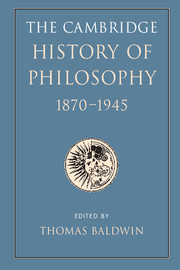Book contents
- Frontmatter
- Contents
- List of contributors
- Introduction
- I 1870–1914
- 1 Positivism, Idealism, and Pragmatism
- 2 Psychology and Philosophy
- 3 Logic, mathematics, and judgement
- 4 Philosophy and the new physics
- 5 The idea of social science
- 6 Ethics, politics, and legal theory
- 7 Philosophy of religion and art
- 24 Sceptical challenges to faith
- 25 The defence of faith
- 26 Art and morality: aesthetics at 1870
- 27 Form and feeling: aesthetics at the turn of the century
- Interlude
- II 1914–1945
- Biobibliographical appendix
- Bibliography
- INDEX
- References
26 - Art and morality: aesthetics at 1870
from 7 - Philosophy of religion and art
Published online by Cambridge University Press: 28 March 2008
- Frontmatter
- Contents
- List of contributors
- Introduction
- I 1870–1914
- 1 Positivism, Idealism, and Pragmatism
- 2 Psychology and Philosophy
- 3 Logic, mathematics, and judgement
- 4 Philosophy and the new physics
- 5 The idea of social science
- 6 Ethics, politics, and legal theory
- 7 Philosophy of religion and art
- 24 Sceptical challenges to faith
- 25 The defence of faith
- 26 Art and morality: aesthetics at 1870
- 27 Form and feeling: aesthetics at the turn of the century
- Interlude
- II 1914–1945
- Biobibliographical appendix
- Bibliography
- INDEX
- References
Summary
During the eighteenth century, the field of aesthetics (first so called by Alexander Baumgarten in Baumgarten [1735: cxvi]) flourished in Britain, France, and Germany, pursued not only by men of letters such as the third Earl of Shaftesbury, Edmund Burke, Denis Diderot, Jean-Jacques Rousseau, Moses Mendelssohn, and Friedrich Schiller, but also by prominent philosophers such as Francis Hutcheson, David Hume, and Immanuel Kant. In Germany, the subject remained central to the metaphysical projects of philosophers such as Friedrich Schelling, Georg Hegel, and Arthur Schopenhauer through the first third of the nineteenth century. In the middle part of the century the subject largely disappeared from the agenda of British philosophers, although it remained a standard subject of philosophical treatises by both Hegelians and their opponents in Germany. By the end of the century, however, aesthetics was once again lively in Britain, Germany, Italy, and the United States, and since then it has continued to be central to the concerns of many major philosophers throughout the twentieth century. This chapter and the next will describe some of the highlights in the revival of aesthetics in the last third of the nineteenth century and around the turn of the twentieth century. This chapter will focus on influential views of art at the beginning of the period, which largely came not from philosophy professors but from more popular writers such as John Ruskin and Friedrich Nietzsche.
On a standard view of the history of modern aesthetics, its central fact has been the development of the idea of the disinterestedness both of the experience of natural and artistic beauty and of the production of art, the idea, that is, that our response to aesthetic properties and our motives for the production of artistic works are autonomous, independent of all our other practical and cognitive interests, a special dimension in which we can enjoy the play of our senses and imagination free of all our usual worries and constraints (see Stolnitz 1961a, 1961b).
- Type
- Chapter
- Information
- The Cambridge History of Philosophy 1870–1945 , pp. 337 - 347Publisher: Cambridge University PressPrint publication year: 2003



